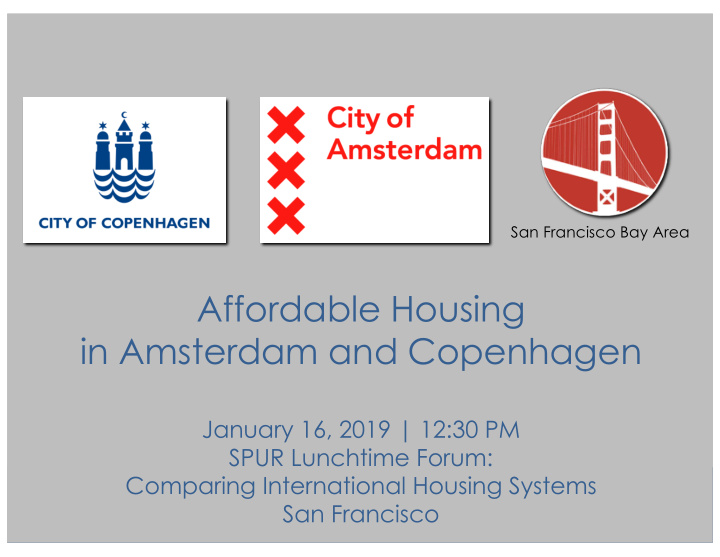



San Francisco Bay Area Affordable Housing in Amsterdam and Copenhagen January 16, 2019 | 12:30 PM SPUR Lunchtime Forum: Comparing International Housing Systems San Francisco
Natalie Bonnewit Bonnewit Development Services bonnewit.com bahousingpeople.com German Marshall Plan Fund of the United States Urban and Regional Policy Fellowship Presenter & Fellowship
Why Amsterdam & Copenhagen? Similarities with SF Bay Area • Commitment to integrated permanent supportive housing and “Housing First” principles • Limited housing stock, tight land supply • Expensive construction costs • Nonprofit housing developer role as owners, developers and long-term property managers • Similar best practice that 20-30% of an affordable housing development should be occupied by homeless and/or special needs households City Comparisons
Why Amsterdam & Copenhagen? Differences between the Cities • Income requirements in Amsterdam and SF Bay Area, not Copenhagen • Individual project ownership legal structure in Copenhagen and SF Bay Area, not Amsterdam • Broader special needs definition in AMS and CPH includes: Single parent households, former prostitutes, students, refugees. Excludes veterans. City Comparisons
Why Amsterdam & Copenhagen? Differences between the Cities • Housing is not a commodity held accountable to investor obligations for certain financial returns as is the case with Low Income Housing Tax Credit but is viewed as a form of social infrastructure serving societal needs which enhances social and economic well-being for everyone • Cultural City Comparisons
2015 Population Number of homeless people in city as a % of total population Copenhagen Amsterdam San Francisco Homeless People 200 200 4,358 * City Population 591,481 841,186 864,816 Metropolitan Region 2,016,285 2,431,000 4,656,132 *Unsheltered, on a given night; in 2018 number is estimated at 6,700 Sources: Cities of Amsterdam, Copenhagen & San Francisco City Comparisons
Housing Stock Non-profit developer controlled affordable units as a % of total housing stock Copenhagen Amsterdam San Francisco Affordable Units 56,660 181,917 30,368 Total Dwelling Units 298,209 399,817 379,597 % Affordable 19% 46% 8% Sources: Cities of Amsterdam, Copenhagen & San Francisco City Comparisons
Amsterdam • 85% of land is owned by City of Amsterdam, facilitates integration • 60% of the housing stock is owned and managed by non-profit housing developers • No project based public funds for development; commercial loans, however, are guaranteed • Non-profits are able collateralize across portfolio and rely on portfolio strength for underwriting new deals Affordable Housing Salient Features
Amsterdam • Operating costs covered by rent and the rent is determined by public regulatory body • Any income-qualifying tenant that needs a rent subsidy can get one • Anybody that needs services will receive them and the insurance company or the City pays the cost • Social Housing industry is supported by legislatively mandated regional entity Affordable Housing Salient Features
Copenhagen • By Danish law each municipality is allowed to require that up to 25% of its housing stock be Common Housing • Common Housing available to all, regardless of income • Cost of construction is regulated which translates to lower rents and smaller unit sizes Affordable Housing Salient Features
Copenhagen • Unlike AMS and SF Bay Area, rent is tied to actual costs • By law, rent is tied to individual unit based on unit size, amenities, etc. Rent may not be lower for special needs households • Social Housing industry is supported by legislatively mandated regional entity Affordable Housing Salient Features
Structural Benefits • Enterprise level/self-supporting financing (little or no public money necessary for development) - De-politicizes of portion of process - Facilitates speed of development • Independent non-profit regional institutions monitor the sector and are mandated by legislation - Self-regulation and self-financing of the AH industry - Facilitates innovation What can we learn?
Financing and Industry Institutional Support Systems - Key Take-Aways Recommendation for legislatively mandated regional body with capacity to: • Provide low cost regional capital • Facilitate a regional queue • Hold pooled reserves • Guaranty commercial real estate loans rather than provide direct loans for some projects Local Applicability
9682 copy
9670 image
• 9823 copy
Mixed income project under construct photo
Photo?
Recommend
More recommend